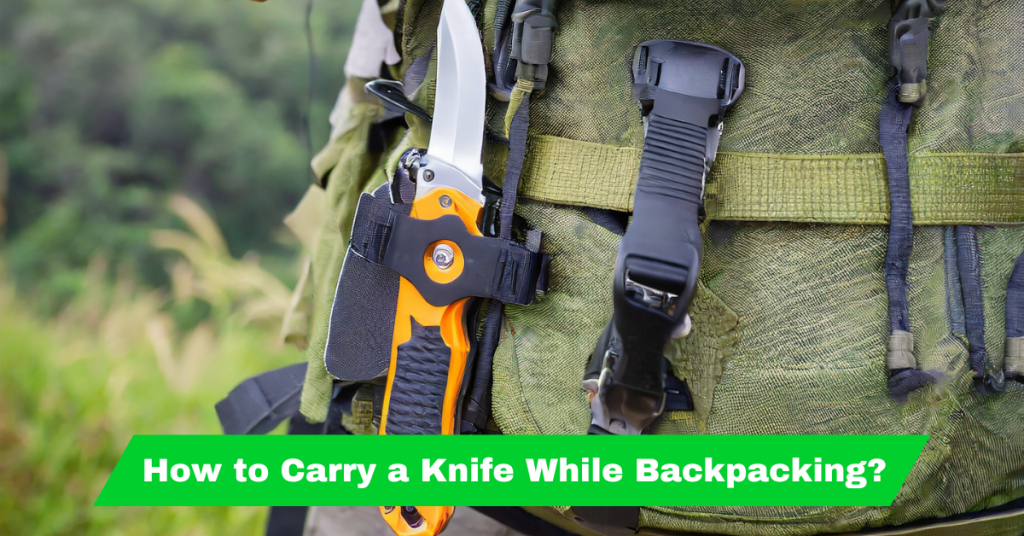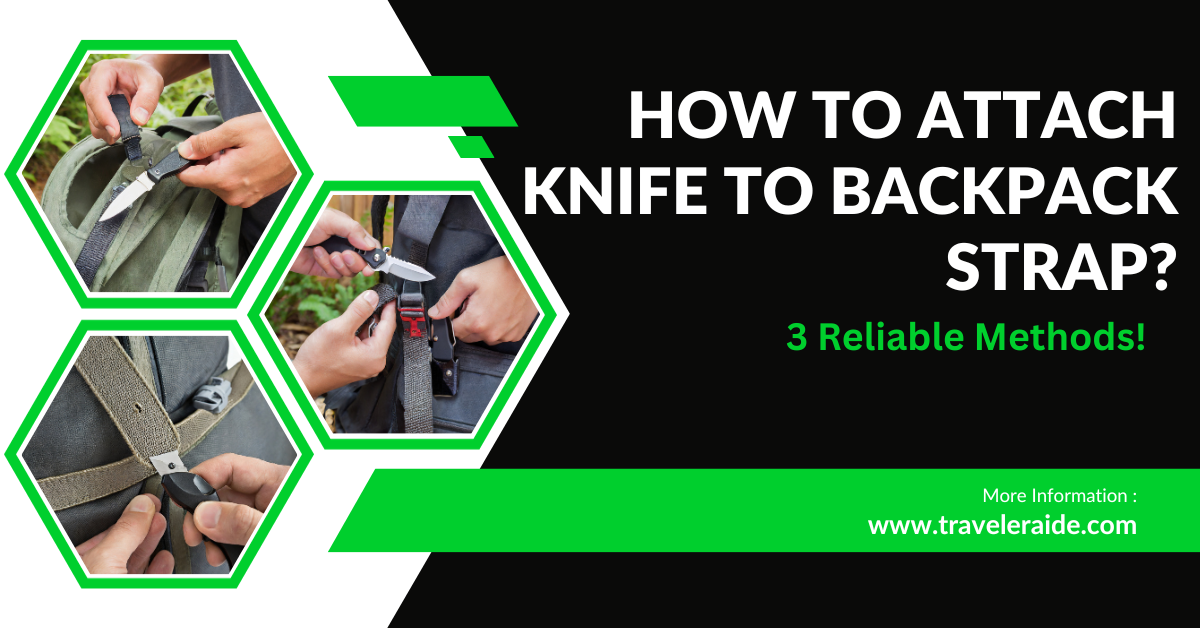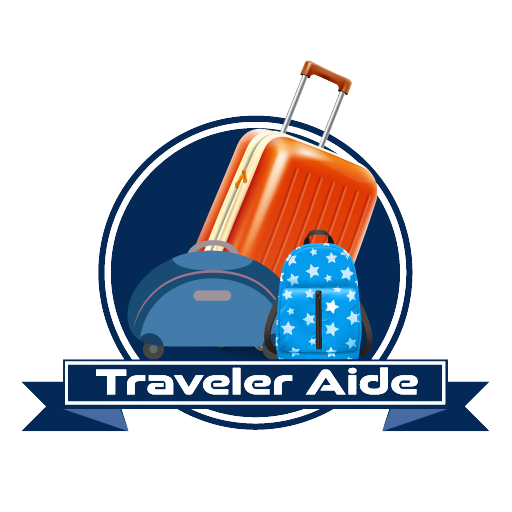Hey, my dear travel-lover friends, I’m Dorothy E. Turner, a Backpack Specialist. I love backpacking and traveling. I’ve spent a lot of time traveling to different places, from towns to mountains. Throughout my journey, I’ve realized the importance of having the necessary gear when traveling. In necessary gear, a dependable knife is one of the most essential items for backpackers.
Whether you’re cutting through dense foliage, preparing food, or facing unexpected situations, a sharp knife is an invaluable tool. But simply carrying a knife isn’t enough; it needs to be readily accessible and securely attached to your backpack for safe and convenient use.
Here, I’ll share my expertise on how to attach knife to backpack strap, ensuring that your trusty companion is always within reach when you need it most.
My Backpack Adventures Experience and the Importance of a Secure Knife --------------------------------------------- Throughout my backpacking journeys, I've encountered numerous scenarios where a knife has proven indispensable. From repairing torn equipment to carving hiking sticks, a knife has consistently been my go-to tool. However, I've also learned the hard way that an improperly attached knife can be a safety hazard. Once, during a trek through the Amazon rainforest, my knife, which was loosely tucked into a backpack pocket, slipped out and fell into a dense thicket of undergrowth. It took me a considerable amount of time to locate it, and the incident made me realize the importance of having a secure attachment system for my knife. Since then, I've experimented with various methods for attaching a knife to my backpack strap, always striving to find the most secure and convenient approach. Over time, I've come up with three methods that I've found to be both practical and reliable, and I'm excited to share them with you today.
How Do You Attach a Backpack Strap?
Attaching a backpack strap is a simple process that can be done in a few minutes.
First, you will need to gather the following materials:
- A backpack
- A strap
- A buckle
- A sewing needle and thread
Next, you will need to locate the attachment points for the strap on the backpack. These are usually located on the top and bottom of the backpack, near the center.
Once you have located the attachment points, you will need to thread the strap through the buckle. Make sure that the buckle is facing the right way, so that the strap will be able to be tightened and loosened.
Next, you will need to thread the strap through the attachment points on the backpack. Make sure that the strap is secure and that it is not twisted.
Finally, you will need to adjust the length of the strap so that it is comfortable to wear. You can do this by tightening or loosening the buckle.
How to Attach Knife to Backpack Strap: 3 Practical and Reliable Ways
There are several ways to attach a knife to a backpack strap, depending on your type of knife and backpack. Here are three of the most common methods that I’ve found to be both practical and reliable.
Essential Safety Precautions
Before we delve into the attachment methods, it’s crucial to emphasize safety. Always put safety first when handling knives, even if they’re not on your backpack.
- Choose the Right Knife: Select a knife with a size and features suitable for your backpacking activities. Avoid overly large or cumbersome knives that could pose safety hazards.
- Maintain a Sharp Edge: A sharp knife is safer than a dull one. A dull knife requires more force to cut, increasing the risk of accidents. Regularly sharpen your knife using appropriate tools and techniques.
- Handle with Care: Treat your knife with respect. Keep it out of reach of children and avoid unnecessary handling. When not in use, ensure the knife is securely closed and stored safely.
Knife Attachment Methods
You can attach a knife to your backpack strap in different ways. Each way has different levels of security and convenience. Choose the method that best suits your needs and preferences.
Method 01: Sheath Attachment:
A sheath is a protective covering designed to hold a knife securely. Most knives have sheaths, but you can buy extra sheaths for different knife types. To attach a sheath to your backpack strap, you can use:
- Sheath Loops: Many sheaths have integrated loops or straps that can be threaded directly onto your backpack strap.
- MOLLE/PALS System: If your backpack has the MOLLE/PALS system, you can attach the sheath securely using MOLLE straps or pouches.
- Lashings: To make the attachment stronger and more personal, use strong cords, like paracord, to tie the sheath directly to your backpack strap.
Method 02: Knife Kydex Sheath:
A Kydex sheath is a special sheath made from a strong and tough plastic material. Kydex sheaths offer excellent retention and protection for your knife. To attach a Kydex sheath to your backpack strap, you can use:
- Sheath Clips: Most Kydex sheaths have clips or mounting points to attach to your backpack strap.
- Tek-Lok System: The Tek-Lok system is a popular accessory for Kydex sheaths. It lets you attach them quickly and securely to backpack straps or belts.
- Custom Mounting: To make the Kydex sheath fit better, you can use MOLLE straps, buckles, or other hardware. Then, attach it to your backpack strap.
Method 03: Knife Retention Devices:
Knife retention devices are accessories that keep your knife securely in its sheath. They are designed to prevent accidental knife falls. They offer extra safety, particularly for activities that involve a lot of movement or uneven terrain.
- Knife Sheath Straps: The straps hold the knife handle in place using strong elastic or webbing material.
- Knife Lanyards: A knife lanyard is a cord attached to the knife handle or sheath. It serves as a secondary safety measure, preventing the knife from being lost even if it falls out of its sheath.
Additional Tips for Attaching a Knife to a Backpack Strap:
- Make sure the knife is not too heavy or bulky for the strap.
- Position the knife so that it is easy to reach and use.
- Make sure the knife is secure and will not fall out.
- Be aware of local laws and regulations regarding the carrying of knives in public.
By following these guidelines and selecting the attachment method that best suits your needs, you can ensure that your knife is always securely attached to your backpack strap, ready to serve you safely and effectively during your backpacking adventures.
Different Benefits and Drawbacks of Each Attachment Method
| Attachment Method | Why Choose It? | Benefits | Drawbacks |
|---|---|---|---|
| Sheath Attachment | Sheath attachments are a traditional and straightforward option. | Provides a simple and reliable method for securing a knife to a strap. | Limited versatility, may lack advanced features for customization. |
| Knife Kydex Sheath | Kydex sheaths offer durability and a secure fit for the knife. | Provides excellent retention and protection, resistant to wear. | Less flexibility in adjustment, may be bulkier compared to others. |
| Knife Retention Devices | Retention devices ensure knives stay securely attached. | Offers added security through advanced locking mechanisms. | Complexity and additional parts may make it bulkier and heavier. |
Each attachment method has its own set of advantages and disadvantages, and the choice depends on individual preferences, the type of knife, and the intended use. Consider the specific needs and priorities when choosing the best attachment method for a backpack strap.
How to Carry a Knife While Backpacking?

Carrying a knife safely and securely is essential for any backpacking trip. A sharp knife is very useful for cooking, cutting plants, and dealing with surprises. It’s important to handle and carry your knife responsibly to avoid accidents and injuries.
Here are some key guidelines for safely carrying a knife while backpacking:
- Choose the Right Knife: Select a knife with a size and features suitable for your backpacking activities. Avoid overly large or cumbersome knives that could pose safety hazards. For backpacking, it’s best to use a strong, durable knife with a full tang.
- Maintain a Sharp Edge: A sharp knife is safer than a dull one. A dull knife requires more force to cut, increasing the risk of accidents. Regularly sharpen your knife using appropriate tools and techniques.
- Secure Attachment: To secure your knife, use a sheath, Kydex sheath, or retention device and attach it to your backpack. Ensure the attachment method is secure and suitable for the type of knife you’re using.
- Handle with Care: Treat your knife with respect. Keep it out of reach of children and avoid unnecessary handling. When not in use, ensure the knife is securely closed and stored safely in your backpack.
- Know Your Surroundings: Be aware of your surroundings when using your knife. Avoid using it in areas with a lot of people or in places where you could cause damage to the environment.
- Proper Technique: Use proper technique when cutting or carving with your knife. Keep your fingers out of the path of the blade, and use a firm grip to control the knife.
- Clean and Store Properly: After using your knife, clean it thoroughly to remove any dirt, debris, or food residue. Store your knife in a dry place to prevent rust and corrosion.
- Respect Local Regulations: Be aware of local regulations regarding knife usage. Some areas may restrict the type of knife you can carry or where you can use it.
- Seek Training: Consider taking a knife safety course to learn proper handling and usage techniques. This can help you prevent accidents and injuries while backpacking.
- Use Your Judgment: Always use your judgment when deciding whether or not to use your knife. If you’re unsure whether a situation requires a knife, err on the side of caution and avoid using it.
Conclusion: A Knife Well Secured is a Backpacker’s Friend
Throughout this guide, you’ve learned that securing your knife to your backpack strap is vital for safe backpacking. Follow the steps I’ve shared above to keep your knife close, ready to help in different situations.
Remember, a properly secured knife is not only more convenient but also safer. By eliminating the risk of your knife falling out or getting tangled, you can focus on your adventures without worrying about potential hazards.
I encourage you to put these techniques into practice on your next backpacking trip. With your knife securely attached to your backpack, you’ll be well-equipped to handle any challenge that comes your way.
Happy trails and safe adventures!
FAQs: Backpack Straps and Knife Attachments
Q: What are the loops for backpack straps?
A: The loops on backpack straps serve various purposes. These are make for adding extra items like carabiners, water bottles, or small pouches. The loops on the backpack make it easy to attach things you need during outdoor activities.
Q: What can I do with extra straps on my backpack?
A: Extra straps on a backpack can utilize for multiple purposes. You can secure loose ends by tying them neatly, preventing flapping in the wind. Additionally, you might use them to attach extra gear externally, like a sleeping bag or a tent. When you travel, consider using Velcro straps or gear ties to stay organized and prevent issues.
Q: How do you attach a knife to a plate carrier?
A: To attach a knife to a plate carrier, use the MOLLE system commonly found on tactical gear. Use a MOLLE-compatible sheath to secure the knife. Weave the straps through the webbing on the plate carrier. Make sure the knife fits well and is easy to reach, while keeping things organized and efficient.
Q: How do you attach a knife to a battle belt?
A: Attaching a knife to a battle belt is similar to the process on a plate carrier. Most battle belts have MOLLE webbing, allowing for secure attachment. Use a MOLLE-compatible sheath. Weave the attachment straps through the webbing on the battle belt. Then ensure the backpack straps adjuster for a secure fit. This will make the knife easy to reach and comfortable to wear.

Hey, I’m Dorothy E. Turner! I’ve spent years exploring the world and diving deep into the travel scene. Along the way, I’ve developed a real knack for understanding what makes a great travel backpack. I’m passionate about sharing my expertise to help fellow travelers find the perfect backpack for their adventures.


